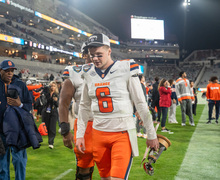WBB : Hillsman opts against timeout at end of game
BATON ROUGE, La. – There were 26 seconds left and, somehow, a gritty Syracuse team clung to a one-point lead – one stop away from the first NCAA Tournament victory in school history.
Hartford head coach Jennifer Rizzotti took a 30-second timeout to call a play. With 16 seconds left, Hartford’s MaryLynne Schaefer took a pass from Jamie McCabe and sunk a long 3-pointer from the left wing.
Rather than call a timeout, Syracuse head coach Quentin Hillsman watched as his team quickly inbounded the ball and raced to the other end. Moments later SU forward Nicole Michael lost the ball out of bounds driving to the hoop along the right baseline, effectively costing SU the game in its 59-55 loss Saturday.
Those final 26 seconds illustrated the differences in coaching philosophy between Rizzotti and Hillsman at the apex of both team’s seasons. On what would be her team’s last possession, Rizzotti took a timeout to set up a play, which ultimately resulted in the game-winning 3-pointer. Hillsman chose not to call a timeout, and SU never get a good shot off.
‘I’m a little nervous when we’ve got the ball in bounds, in our point guard’s hands and we get everybody set up on the floor,’ Hillsman said. ‘Why take a time out?’
Rizzotti’s philosophy may have triumphed, but the head coach admitted after the game that the play hardly went as planned. If her team’s shot selection had seemed odd, that’s because it was – a long, contested 3-pointer on what could be a team’s last chance, when all it needed was a field goal to take the lead or a free throw to tie the game.
Rizzotti said after the game that Schaefer was supposed to attract attention from Syracuse, enticing defenders to come out from the low post to contest the shot. When that happened, Schaefer was to look for either Erica Beverly or Diana Delva, who were stationed at the low post.
But the defensive shift Rizzotti anticipated didn’t happen to the extent she thought it would, and Schaefer was left open just enough to sink the game-winner.
‘I just didn’t really think about it,’ Schaefer said. ‘I had an open look, and good thing it went in.’
The play itself might not have produced the game-winner, but the set Rizzotti called might have been enough to knock the SU defense off-balance.
‘It was the first time we had run that baseline runner set, and I think it threw them off guard,’ Rizzotti said. ‘They didn’t quite shift everybody.’
Hillsman said his players moved out on Schaefer, who was forced to take her shot from a few feet behind the line.
‘She made a great adjustment, and we did get a great fly out,’ Hillsman said. ‘We talked about if they get a catch from the inside out, we fly out at the shooter. She made a catch, we fly out, she makes it.’
Faced with a similar situation, Hillsman took the other road, and trusted his players. He said the scenario was one his team works on every day in practice, and his decision not to call a timeout is based on a risk-reward assessment. Calling a timeout, Hillsman said, poses a high risk of a turnover on the inbound play, and thus isn’t worth the reward of calling a set play.
But that strategy ended up working against the Orange, which was forced to foul after Michael’s turnover. Schaefer iced the game with two free throws, handing SU its season-ending loss.
After a quiet first half, with only three points, Schaefer exploded in the second with 16, including her team’s final eight points. And after the game, a beaming Schaefer relived what, to her estimation, was the first game-winner of her basketball career.
‘I think when you’re younger you think about taking a potential game-winning shot,’ Schaefer said. ‘It’s just a great feeling.’
Published on March 24, 2008 at 12:00 pm





